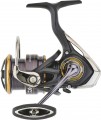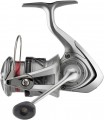Number of bearings
The number of bearings provided in the design of the reel. Bearings are used to reduce friction of rotating parts, which, on the one hand, protects such parts from wear, and on the other hand, reduces excessive effort expended when the handle is rotated. Accordingly, the
more bearings, the more friction units are protected and the better the coil is “optimized”; this parameter is a good indicator of the overall class of the product. At the same time, it is necessary to evaluate different models taking into account their purpose (see "Type").
So, in fly fishing reels, even quite expensive ones, 1 bearing is usually provided — at the point of installation of the drum on a bracket designed for attachment to the rod. This is actually the only significant friction point, so more bearings are simply not required. For multiplier reels, this number varies from 1 for relatively simple options to 6 – 7 for premium ones. And in inertia-free bearings, the number of bearings can reach a couple of dozen.
Winding the line per turn
This parameter determines how much line is wound/unwound in one full turn of the handle. The greater the value of the line winding per revolution, the less force must be applied when pulling the catch, at the same time, the winding speed also increases. An average ordinary reel winds around 50 cm of fishing line in one turn of the handle.
Pulling force
Pulling force determines the maximum weight that the reel can regularly pull on itself, without negative consequences in the future. So, the pulling force of the average coil is at the level of 2-3 kg. Such a model can be entrusted with pulling ashore, with the help of one reel, most of the freshwater fish, from crucian and carp to bream, perch and carp. If you plan to catch catfish, pike or sea fish, then it is better to use a reel with high traction.
Also note that experienced fishermen usually pull the catch ashore not at the expense of the reel, but with the rod itself, using the “fighting” technique. Working with a rod allows you to almost significantly unload the reel.
Weight
The total weight of the reel (only the device itself, without fishing line). This parameter is important, first of all, for those who select equipment of
the ultralight class — in such gear, the struggle is, as they say, for every extra gram. In other cases, you can not pay special attention to weight.

